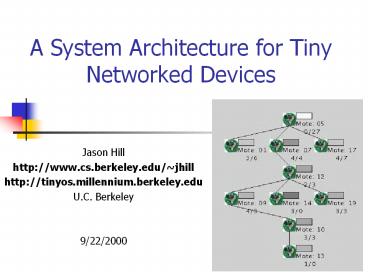A System Architecture for Tiny Networked Devices - PowerPoint PPT Presentation
1 / 15
Title:
A System Architecture for Tiny Networked Devices
Description:
To develop an ultra low power networked sensor platform, ... flow-thru, not wait-command-respond = must handle multiple inputs and outputs simultaneously ... – PowerPoint PPT presentation
Number of Views:18
Avg rating:3.0/5.0
Title: A System Architecture for Tiny Networked Devices
1
A System Architecture for Tiny Networked Devices
- Jason Hill
- http//www.cs.berkeley.edu/jhill
- http//tinyos.millennium.berkeley.edu
- U.C. Berkeley
- 9/22/2000
2
Goals
- To develop an ultra low power networked sensor
platform, including hardware and software, that
enables low-cost deployment of sensor networks. - To be a system level bridge that combines
advances in low power RF technology with MEMS
transducer technology.
3
Key Characteristics of TNDs
- Small physical size and low power consumption
- gt Limited Physical Parallelism and Controller
Hierarchy - gt primitive direct-to-device interface
- Concurrency-intensive operation
- flow-thru, not wait-command-respond
- gt must handle multiple inputs and outputs
simultaneously - Diverse in Design and Usage
- application specific, not general purpose
- huge device variation
- gt efficient modularity
- gt migration across HW/SW boundary
- Largely Unattended Numerous
- gt robust operation
- gt narrow interfaces
4
MoteThe Hardware
COTS Dust
weC Mote
- 4Mhz, 8bit MCU (ATMEL)
- 512 bytes RAM, 8K ROM
- 900Mhz Radio (RF Monolithics)
- 10-100 ft. range
- Temperature Sensor
- Light Sensor
- LED outputs
- Serial Port
5
Second Generation Mote
- Two Board Sandwich
- Main CPU board with Radio Communication
- Secondary Sensor Board
- Allows for expansion and customization
- Current sensors include Acceleration, Magnetic
Field, Temperature, Pressure, Humidity, Light,
and RF Signal Strength. - Can control RF transmission strength Sense
Reception Strength
6
Tiny OS The Software
- Provides a component based model abstracting
hardware specifics from application programmer. - Capable of maintaining high levels of
concurrency. - Allows multiple applications to be running.
- Services Provided Include
- RF messaging protocols.
- Periodic Timer Events.
- Asynchronous access to UART data transfers.
- Mechanism for Static, Persistent Storage.
- Can Swap Out system components to get necessary
functionality. - Complete applications fit in 4KB of ROM and 256B
RAM.
7
Tiny OS Internals
- Scheduler and Graph of Components
- constrained two-level scheduling model tasks
events - Component
- Frame (storage)
- Tasks (concurrency)
- Commands, and Handlers (events)
- Constrained Storage Model
- frame per component, shared stack, no heap
- Very lean multithreading
- Layering
- components issue commands to lower-level
components - event signal high-level events, or call
lower-level commands - Guarantees no cycles in call chain
8
TOS Component
/ Messaging Component Declaration
/ //ACCEPTS char TOS_COMMAND(AM_SEND_MSG)(char
addr,char type, char data) void
TOS_COMMAND(AM_POWER)(char mode) char
TOS_COMMAND(AM_INIT)() //SIGNALS char
AM_MSG_REC(char type, char data) char
AM_MSG_SEND_DONE(char success) //HANDLES char
AM_TX_PACKET_DONE(char success) char
AM_RX_PACKET_DONE(char packet) //USES char
TOS_COMMAND(AM_SUB_TX_PACKET)(char data) void
TOS_COMMAND(AM_SUB_POWER)(char mode) char
TOS_COMMAND(AM_SUB_INIT)()
Commands
Events
9
Composition to Complete Application
Route map
router
sensor appln
application
Active Messages
packet
Serial Packet
Temp
Radio Packet
SW
byte
HW
UART
Radio byte
i2c
photo
bit
clocks
RFM
10
Programming with CAD
- Can assemble overall system using structural VHDL
- Scripts pre-process VHDL at compile time
- Allows for compile time resolution of event
handlers - Eliminates need for registration mechanisms and
dynamic dispatch - Automatically allows events to be handled by
multiple components. (TX_Done) - Significantly more flexibility than library based
component models
11
Event Based Programming Model
- System composed of state machines
- Each State Machine is a TinyOS component
- Command and event handlers transition a component
from one state to another - Quick, low overhead, non-blocking state
transmissions - Allows many independent components to share a
single execution context - Emerging as design paradigm for large scale
systems - Tasks are used to perform computational work
- Run to completion, Atomic with respect to each
other
12
Dynamics of Events and Threads
- Message Send Transition
13
Empirical Breakdown of Effort
- can take apart time, power, space,
- 50 cycle thread overhead, 10 cycle event overhead
14
Migration of the Hardware Software Boundary
- TinyOS component model propagates hardware
abstractions into software. - Allows for a migrations of software components
into hardware - Example
- Bit level radio procession component could be
implemented as specialized FIFO with complex
pattern matching.
15
Storage Breakdown (C Code)
3450 B code 226 B data
16
Multi-Hop Routing Demo
- Sensors automatically assemble and determine
routing topology - Parallel Breadth First Search
- Shortest path to all nodes remembered
- Base station broadcasts out routing information
- Individuals listen for and propagate route update
- N messages sent
- Generational scheme to prevent cycles in routing
table
Base
17
Demo (cont.)
- Sensor information propagated up routing tree
- Statistics kept for number of readings received
and number of packets forwarded by each node - Sensors transmit data when significant events
occur or when time limit is exceeded - Must be continuously listening for packets to be
forwarded impacts power considerations
18
Future Goals
- Short Term
- Deploy sensor net for week long trials
- Target Civil Engineerings and The Center For the
Built Environments needs for a real world
deployment. - Determine algorithms for aggregation and analysis
of data inside the network. - Support applications where data is picked up by
roaming data collection nodes. - Long Term
- Deploy networks of 1000s of nodes
- Year long, unattended deployments































